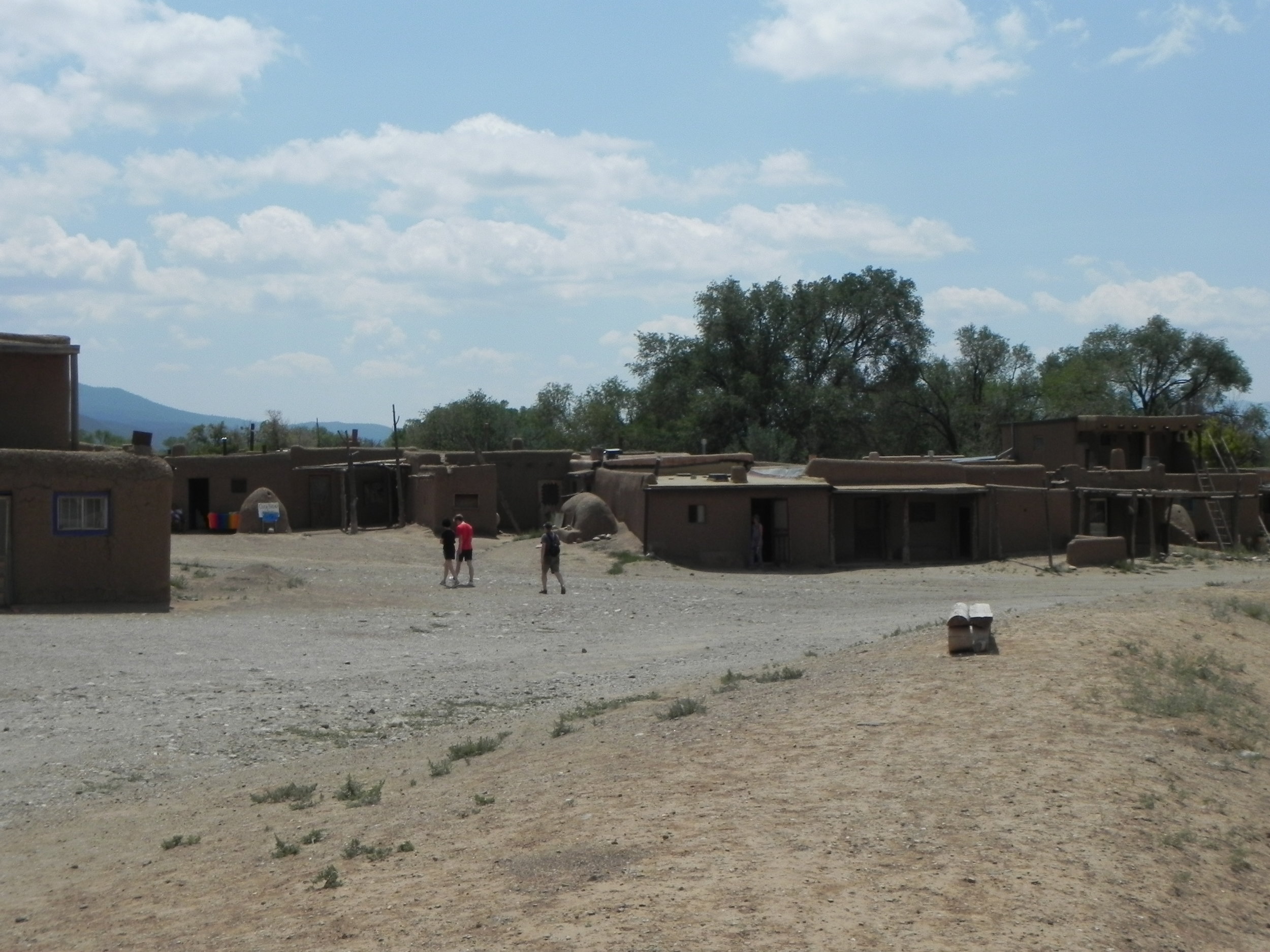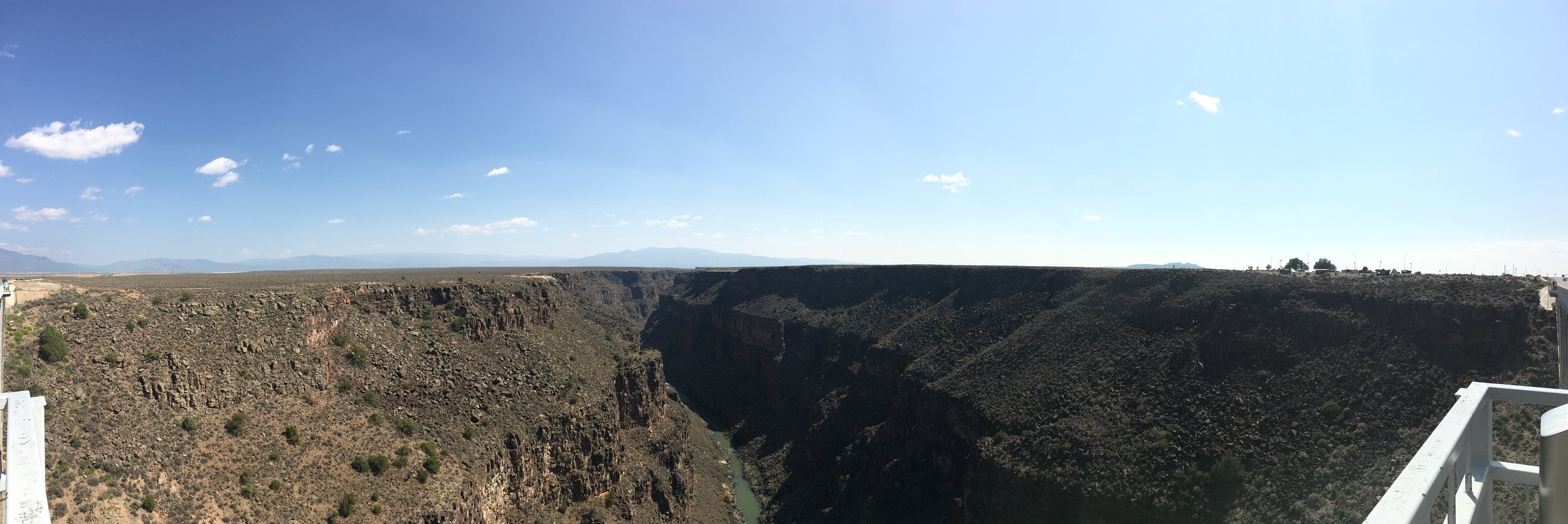Cross-country to Key West: Taos to the Chiricahuas
Taos is a worthwhile visit. It’s not as developed as Santa Fe and it has some really nice locally owned restaurants. We spent a couple nights here so we had a day to do some local touring. We didn’t go back to the ski resorts because we wanted to see the Taos Pueblo, just a couple miles up the highway.
The first night we walked to the Alley Cantina just north of the Taos Plaza, a short walk from the Windmark, where we were staying. The Cantina’s got really good food but be wary of the spice. I didn’t have a problem but the green chicken chili was really spicy for Cath’s taste, despite the waiter’s statement that it wasn’t. I’d still recommend this as a place to eat.
No place in Taos is inexpensive, just a matter of how high. Breakfast at the Bent Street Cafe and Deli is definitely a good thing. Locals definitely make it a stop. There was a group of about 8 old dudes, look who’s talking, that apparently get together for breakfast every week. They’re there often enough for the staff to know what each guy wanted for breakfast.
We had dinner our second night at Stella’s Italian Restaurant. We were pleasantly surprised by the quality of the food. It’d be worth your time and taste buds work-out.
We had to find places off-site since the Windmark resort does not have a restaurant. The suite was nice. Two bedrooms with ensuites for each and a kitchen that we were not prepared for. Good thing because there weren’t a lot of eating and cooking equipment in the unit. We were not too impressed. It was one of the less expensive places to stay in the town’s center, and that’s not saying much because it was one of the more expensive rooms we had on the trip. We justified the cost because we were about to save a week, and more, on rooms while we visited Eric and Gina on the vineyard and my brother’s in Sun City.
This is one of the few times I’ve taken opportunity to review a site on it’s website. I can’t see why someone would put out money for a timeshare here. The only thing a member has that we didn’t is free wifi and that’s no benefit. It was so poor that we couldn’t use it for our devices. We had to use cellular data for all our internet access. The Wyndham Baymont motels that we stayed at had better wifi and it was free for little more than half the cost, and you got a breakfast opportunity. I stated this in my comments and, to no surprise, they have not contacted me about becoming a member of the Wyndham resorts. I wonder why.
The Taos Pueblo is worth the price of admission. It’s the only living Native American World Historic site. (http://taospueblo.com/) The main buildings have been carbon dated and they have been actively occupied for over 1000 years. Teddy Roosevelt had the Taos tribe’s property taken for a park and it took the tribe almost 70 years to get it returned to them. The residents of the pueblo live traditionally within s the walls of the pueblo. This means no running water or electricity. They still use outdoor ovens, every home has one, and perform traditional tasks for crafts, pottery, etc which is a prime form of income for the residents. The tour guide we had is a student of archeology at one of the state’s universities and does tours during the summer. The guides only make what they get in donations after the tours.
The tribe was almost wiped out by the US military in the mid-1800’s. The Taos were not militant peoples but the first American governor, Bent, was so bad that the Taos and the local Spanish settlers banded together and revolted, killing him in his home. From the way he treated the locals it was well-deserved. In response the US army attacked the pueblo. When they did the Taos sheltered in their church, expecting to be safe. The army bombarded the church with artillery, a common practice, and killed everyone inside. The only tribal members that survived were the ones that took to the mountains. The site of the church was turned into a cemetery for the tribe. It’s now too full to allow members to be buried there but the grave sites are maintained by the families. There is a large pile of crosses by what’s left of the original church. These are the ones that have to be replaced and the families keep the originals when they replace them. The water source for the pueblo is the creek from the mountains, just as it has been for centuries. They are very protective of their land because the Red Willow is their life blood, even today.
Leaving the pueblo we decided to do a drive north, to maybe do the circle drive around and through the mountains, check out the remaining ski areas to the north. As we headed up the road we saw a sign for the Rio Grande Gorge Bridge. What the hell? Make the turn and check it out, that’s what these trips are for. The gorge is only 7 miles west of the highway so it would be a fairly short trip. As you drive out there it’s flat, all the way to the mountains in the west. You see nothing to indicate that there’s a major landform out there. Suddenly, it’s there. A bridge in the middle of a huge plain and under the bridge a great gorge that starts in Colorado and runs south to just north of Santa Fe where it turns into a river bottom. As you drive out of Taos you start dropping in elevation till you get to the lower end of the gorge and cross the river. I couldn’t help but think of the early travelers who, after fighting over the Rockies and the desert, saw a large flat plain and easy traveling, until, ARRRGGGHHHH! Who put this huge hole out there? The deity was really messing with them. The gorge is about as deep as the Columbia, to the level of the river. The Columbia, with the depth of its reservoirs is deeper overall.
After we arrived at the rest area/park by the bridge we walked out to the middle for photos. I placed the panoramas at the start of my last blog but will put them here again to go with the others so you don’t have to jump back and forth.
Rio Grande Gorge looking south
Rio Grande Gorge looking north
Driving south past Albuquerque you follow the Jornada del Muerta, named for a human skeleton found along the Rio Grande trail, the path used by the Spanish as they explored the southwest. There’s a rest stop along here that tells the story of an unsavory character during the early years of the occupation, that had to leave Santa Fe in a hurry, on a borrowed horse. Search parties went out to capture him but never found him. Many years later the human, and a horse skeleton, were found along the river. Therefore, the name.
The rest stop has an interesting design. Everything except the parking lot is built on platforms to keep travelers from harming the sensitive environment and protecting the travelers from the environment (rattlesnakes). We didn’t see any but it was mid-day and hot so the snakes were all looking for shade. After leaving the rest stop we could see a massive storm on the horizon. It was headed north, right along the interstate, following the Rio Grande valley between the mountains.
Now, we saw big thunderstorms in North Carolina and Louisiana. The one in Louisiana had such hard rain that I had to pull off into a handy gas station till it passed. Otherwise we would have had to stop on the side of the road. Out here there was no place to pull off except for the shoulder, and it wasn’t going to be safe to do so. I had to keep moving at 15-20 mph to avoid having a semi run up my tail pipe. The rain only lasted 3 minutes but in that time the temperature dropped from 95 to 65! I’ve been in 20 degree drops, but never a 30 degree one. About 10 minutes after the storm, as we headed downhill through a cut in the hillsides toward a creek I saw what appeared to be a metal billboard up on the side of the highway. This hit me as being odd, interstates don’t have billboards, and it was at an angle near the top of the 25-30 degree slope. As we got nearer I could tell it was a semi trailer 300 or more feet up the hill. I saw tire tracks in the grass leading off the shoulder and aiming at the trailer so it obviously ran off the road, and up the hill. As we passed we saw that the tractor was still attached, at an extreme, jackknifed angle, but everything was still on its wheels. The cab’s door was open and we could see the driver sitting there pounding on his cell phone.
I looked for the mileage posts to get the location, between MP 118 & 117, and waited for the next exit hoping there would be somewhere to contact the police. Out here AT&T doesn’t work. In fact, on a lot of our trip once you got away from city centers into the hinterland, like North Carolina, and much of New Mexico and Arizona there’s no service. We pulled off at a place called the Santa Fe Cafe, a little cafe and gas station in the middle of nowhere. Luckily there were two guys inside and one called the sheriff. The driver was going to need a big tow because there was no way he was going to get that thing off the hill and back on the road by himself.
Eric had asked us to stop in Deming, NM to pick up some wine at St. Clair winery for a bottle of their Petit Verdot and some local honey, which helps with fighting allergies from the local flora. They were out of honey but we found it at the Diaz Family Farm store. We also stopped at Luna Rossa winery on the south side of Deming and bought a bottle of their Nino red blend then headed for Rodeo, NM and the vineyard.
I’ve been at this for a couple hours and now want to stop for the day. While typing I accidently hit a combination of keys on the board as I quickly type and all the text that I had input gets highlighted and deleted before I can stop it. I’ve had to rewrite most of the text above these photos 4 times today and I’m throwing in the towel for today.
So,,,Ciao for now.





































